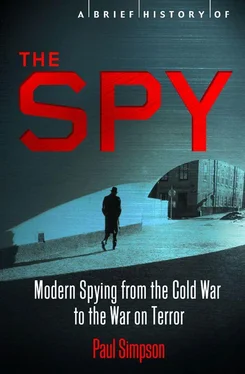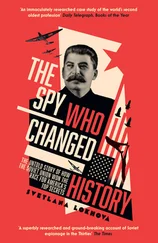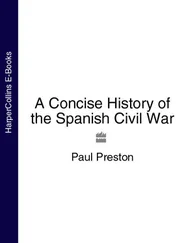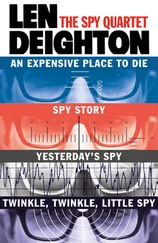Paul Simpson - A Brief History of the Spy
Здесь есть возможность читать онлайн «Paul Simpson - A Brief History of the Spy» весь текст электронной книги совершенно бесплатно (целиком полную версию без сокращений). В некоторых случаях можно слушать аудио, скачать через торрент в формате fb2 и присутствует краткое содержание. Город: London, Год выпуска: 2013, ISBN: 2013, Издательство: Constable & Robinson, Жанр: Прочая документальная литература, на английском языке. Описание произведения, (предисловие) а так же отзывы посетителей доступны на портале библиотеки ЛибКат.
- Название:A Brief History of the Spy
- Автор:
- Издательство:Constable & Robinson
- Жанр:
- Год:2013
- Город:London
- ISBN:9781780338910
- Рейтинг книги:3 / 5. Голосов: 1
-
Избранное:Добавить в избранное
- Отзывы:
-
Ваша оценка:
- 60
- 1
- 2
- 3
- 4
- 5
A Brief History of the Spy: краткое содержание, описание и аннотация
Предлагаем к чтению аннотацию, описание, краткое содержание или предисловие (зависит от того, что написал сам автор книги «A Brief History of the Spy»). Если вы не нашли необходимую информацию о книге — напишите в комментариях, мы постараемся отыскать её.
A Brief History of the Spy — читать онлайн бесплатно полную книгу (весь текст) целиком
Ниже представлен текст книги, разбитый по страницам. Система сохранения места последней прочитанной страницы, позволяет с удобством читать онлайн бесплатно книгу «A Brief History of the Spy», без необходимости каждый раз заново искать на чём Вы остановились. Поставьте закладку, и сможете в любой момент перейти на страницу, на которой закончили чтение.
Интервал:
Закладка:
However, towards the end of the seventies, the IRA began their campaign again; they attacked a barracks in Germany, and set multiple bombs in English cities in December 1978. A new campaign in England seemed under way but fizzled out. But then an offshoot Marxist group, the Irish National Liberation Army, scored a success, blowing up Conservative MP Airey Neave as he drove out of the House of Commons in May 1979. The IRA equalled this with the murder of the Queen’s cousin, Lord Mountbatten, and three others at Sligo, north-west Eire, as well as detonating bombs that killed eighteen soldiers on 27 August 1979.
The IRA continued to be a threat to security throughout the eighties; the IJS, now run by MI5, provided intelligence that helped counter their activities. MI5 also cooperated with the FBI in an effort to combat American financial aid to the IRA via the Irish Northern Aid Committee (NORAID) and the less well-known Clan na Gael, a secret Republican society. In 1984, the IJS was wound up, and its operations brought totally in-house at MI5. Although the counter-terrorism forces had some successes, they were not able to prevent spectacular coups by the IRA, such as the bombing of the Grand Hotel in Brighton on 16 October 1984 that nearly took the life of Prime Minister Margaret Thatcher.
MI5 did assist with the tracking of an IRA Active Service Unit across Europe in 1988 that culminated in the deaths of three of its members on Gibraltar on 6 March (although the subsequent media controversy over an alleged shoot-to-kill policy did none of the intelligence or army agencies any favours). This was indicative of an increased pan-European policy against the IRA that was spearheaded by the Security Service, while the FBI assisted with the arrest of an electronics expert in the US who had been helping the IRA with their technical requirements.
As borders opened within Europe during 1990, the IRA began a fresh campaign, and in February 1991 they fired a mortar bomb at the Cabinet Room at 10 Downing Street. In November that year, Prime Minister John Major agreed that MI5 should now take over responsibility for all counterterrorism matters; that decision became formal six months later. The IRA’s campaign in the UK continued unabated, with one explosive device at the Baltic Exchange in the City of London in April 1992 leading to around £800m of insurance claims — although back channel contacts between the IRA leadership and the British Government, which would eventually lead to the Good Friday agreement, were reopened for a time.
The Republicans’ campaign suffered a major setback when their key operatives Rab Fryers and Hugh Jack were arrested in July 1993, together with the material for six car bombs. MI5 reported that over the following twelve months, eighteen out of thirty-four IRA mainland operations were frustrated. A ceasefire was declared in August 1994 which lasted until February 1996; bombs planted in spring 1996 at Canary Wharf and Manchester’s Arndale Centre were not as devastating as the IRA had hoped. An Active Service Unit comprising some of the IRA’s most able members was put under surveillance by MI5 and arrested in July before they could disrupt London’s power supply.
The ceasefire came back into effect three weeks after the Labour party’s electoral victory in Britain in May 1997; less than a year later, Prime Minister Tony Blair said it wasn’t the day for sound bites, but he felt ‘the hand of history on his shoulder’, as he prepared to sign the Good Friday Agreement.
America also faced domestic terrorists. Although counterterrorism wouldn’t become the official fourth priority for the FBI until 1982, they dealt with various high-profile cases before then. These included the bombing at the University of Wisconsin-Madigan on 24 August 1970, in which an Army think tank, the Mathematics Research Center, was attacked by radicalized students protesting the Vietnam War; and the campaign waged by the Weather Underground Organisation (better known as the Weathermen). Their manifesto, Prairie Fire, claimed in 1974 that their intention was ‘to disrupt the empire… to incapacitate it, to put pressure on the cracks’. They carried out over two dozen bombings, including one at the State Department in Washington DC in January 1975. Those responsible were tracked down by the FBI over many years and brought to justice.
The FBI also tried to capture the Unabomber, Theodore Kaczynski, who sent explosive devices over a period of seventeen years from 1978. He was only caught after he sent a ‘manifesto’ to the FBI in 1995 explaining why he was carrying out his attacks; when it was printed, his brother David provided convincing proof that Ted was responsible.
The Bureau spent five years hunting down Eric Rudolph, who had been responsible for a bomb at the Centennial Olympic Park in Atlanta during the 1996 Summer Olympics. He planted further devices over a two-year period at abortion clinics and gay-friendly meeting places in Alabama before disappearing into the Appalachian wilderness and living rough. He was eventually caught while searching for food in a dumpster.
They were rather quicker tracking down the Oklahoma Bomber, former soldier Timothy McVeigh, whose homemade device killed 168 and injured hundreds more on 19 April 1995 — partly because he had actually been arrested for carrying a concealed weapon a mere ninety minutes after the blast. Nearly a billion pieces of information were reviewed in preparation for McVeigh and his co-conspirators’ trial. McVeigh was executed on 11 June 2001. Suggestions that he had connections with Middle Eastern terror groups have never been proven.
When papers wrote about Middle East terrorists in the forties, they were usually referring to the Zionist extremists who were seeking to set up the state of Israel. However, with the arrival of the Popular Front for the Liberation of Palestine (PFLP) in 1968, the emphasis switched to the Arabs, and once al-Qaeda started to make a name for itself with various terrorist attacks during the nineties, the volatile region became the focal point for agencies worldwide.
With the exception of the Israeli security agencies, notably their secret service Mossad, most of the world’s intelligence agencies weren’t particularly pro-active in their attitude to potential terrorist threats emanating from the Middle East during the seventies and eighties. The terrorists of the PFLP, guided by Dr Wadi Haddad, devised a new strategy: hijacking aircraft. The first, in July 1968, was an El Al Boeing 707 bound for Tel Aviv (the one and only time an aircraft belonging to the Israeli national airline would be successfully hijacked). Haddad was eventually recruited as a KGB agent, giving the Soviets some control over the PFLP’s actions. The terrorist group’s actions escalated culminating in the attempted capture of four aircraft on 6 September 1970 with a fifth following three days later. Known as the Dawson’s Field hijackings after the RAF base in Jordan to which the planes were flown and then blown up, this resulted in King Hussein of Jordan taking violent action against the newly formed Palestine Liberation Organisation led by Yasser Arafat.
While most intelligence agencies were focusing on securing airports and aircraft, the Israelis went a step further. When a Sabena aircraft was diverted to Lod airport in Israel by the PFLP in May 1972, they sent in special forces disguised as airport workers and recaptured the plane. This escalated the situation. Three weeks later, members of the Japanese Red Army Faction, working for the PFLP, massacred twenty-six passengers at Lod. And on 5 September, Black September, an offshoot of the PLO, killed two Israeli athletes and took nine hostages at the Munich Olympic Games. A firefight at the airport led to the death of all the hostages. With the help of assets that they had within the PLO, Mossad tracked down those responsible for the attack, and executed them (regrettably killing some innocents along the way, notably in Lillehammer, Norway, in July 1973, when Ahmed Bouchiki was murdered in the belief he was Ali Hassan Salemeh. According to Mossad chief Zvi Zamir:
Читать дальшеИнтервал:
Закладка:
Похожие книги на «A Brief History of the Spy»
Представляем Вашему вниманию похожие книги на «A Brief History of the Spy» списком для выбора. Мы отобрали схожую по названию и смыслу литературу в надежде предоставить читателям больше вариантов отыскать новые, интересные, ещё непрочитанные произведения.
Обсуждение, отзывы о книге «A Brief History of the Spy» и просто собственные мнения читателей. Оставьте ваши комментарии, напишите, что Вы думаете о произведении, его смысле или главных героях. Укажите что конкретно понравилось, а что нет, и почему Вы так считаете.












